Genetic Epidemiology Report: Benefits and Challenges in Human Health
VerifiedAdded on 2019/09/23
|6
|1445
|293
Report
AI Summary
This report provides a comprehensive overview of genetic epidemiology, focusing on the study of genetic behavior and its influence on human health. The analysis examines the interaction between genetic and environmental factors in disease expression, highlighting the evolution of genetic analysis from inheritance pattern studies to linkage analysis and GWAS. The report discusses the purpose of the study, major findings, positive aspects of the author's work, limitations, and data supporting the author's claims. It explores advancements in genetic epidemiology, such as the human genome project and GWAS, and their contributions to understanding complex diseases. The report also addresses future improvements, ethical dilemmas, and unanswered questions in the field, concluding with the importance of genetic epidemiology in advancing therapeutic purposes and disease prediction. The references include relevant research articles that support the analysis of genetic epidemiology.
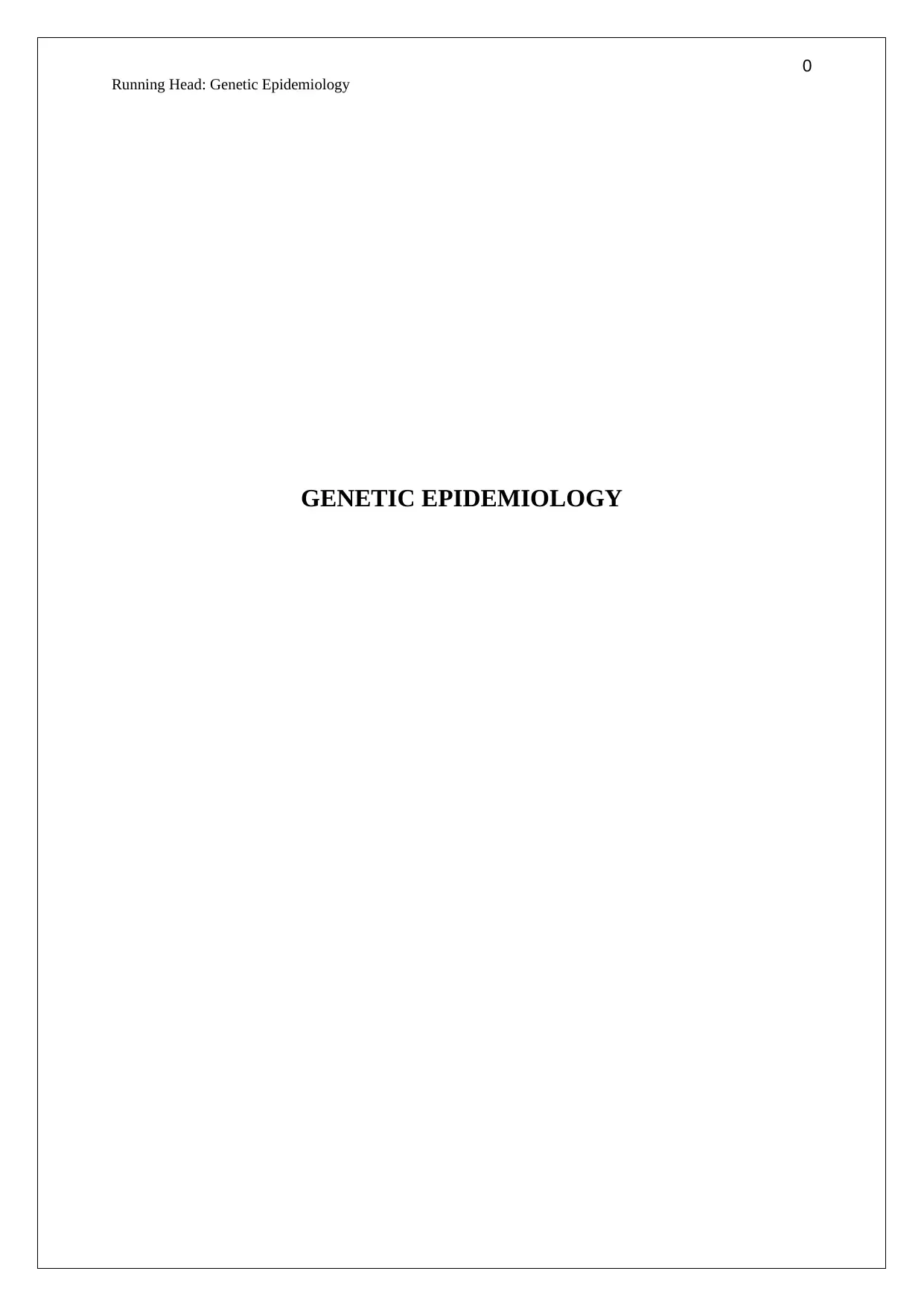
0
Running Head: Genetic Epidemiology
GENETIC EPIDEMIOLOGY
Running Head: Genetic Epidemiology
GENETIC EPIDEMIOLOGY
Paraphrase This Document
Need a fresh take? Get an instant paraphrase of this document with our AI Paraphraser

1
Genetic Epidemiology
Table of contents
Introduction................................................................................................................................2
Purpose of the study...................................................................................................................2
Major findings............................................................................................................................2
Positive aspects of author...........................................................................................................3
Data to support author................................................................................................................3
Future improvements.................................................................................................................4
Questions remained unanswered................................................................................................4
Conclusion..................................................................................................................................4
Reference list..............................................................................................................................5
Genetic Epidemiology
Table of contents
Introduction................................................................................................................................2
Purpose of the study...................................................................................................................2
Major findings............................................................................................................................2
Positive aspects of author...........................................................................................................3
Data to support author................................................................................................................3
Future improvements.................................................................................................................4
Questions remained unanswered................................................................................................4
Conclusion..................................................................................................................................4
Reference list..............................................................................................................................5
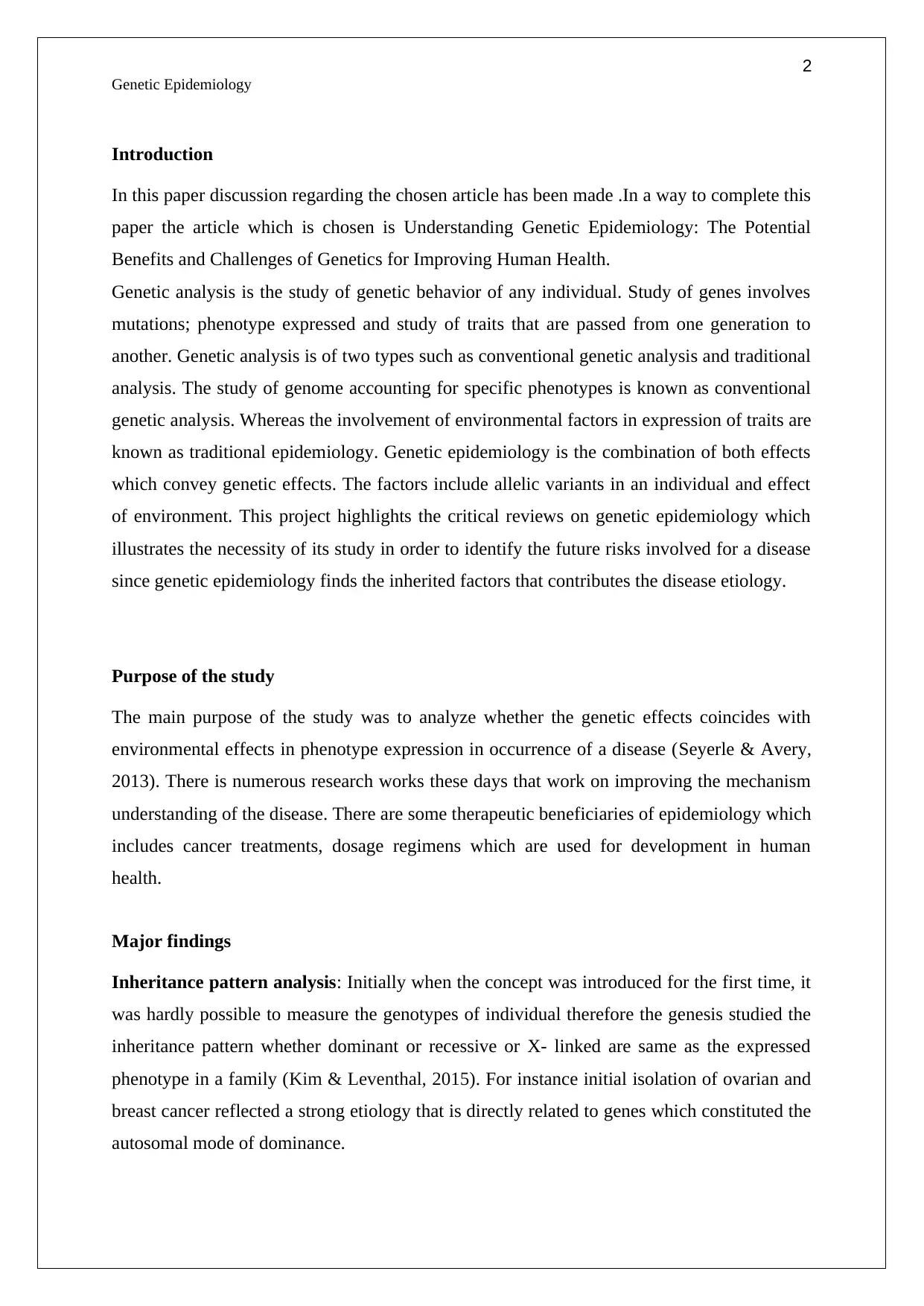
2
Genetic Epidemiology
Introduction
In this paper discussion regarding the chosen article has been made .In a way to complete this
paper the article which is chosen is Understanding Genetic Epidemiology: The Potential
Benefits and Challenges of Genetics for Improving Human Health.
Genetic analysis is the study of genetic behavior of any individual. Study of genes involves
mutations; phenotype expressed and study of traits that are passed from one generation to
another. Genetic analysis is of two types such as conventional genetic analysis and traditional
analysis. The study of genome accounting for specific phenotypes is known as conventional
genetic analysis. Whereas the involvement of environmental factors in expression of traits are
known as traditional epidemiology. Genetic epidemiology is the combination of both effects
which convey genetic effects. The factors include allelic variants in an individual and effect
of environment. This project highlights the critical reviews on genetic epidemiology which
illustrates the necessity of its study in order to identify the future risks involved for a disease
since genetic epidemiology finds the inherited factors that contributes the disease etiology.
Purpose of the study
The main purpose of the study was to analyze whether the genetic effects coincides with
environmental effects in phenotype expression in occurrence of a disease (Seyerle & Avery,
2013). There is numerous research works these days that work on improving the mechanism
understanding of the disease. There are some therapeutic beneficiaries of epidemiology which
includes cancer treatments, dosage regimens which are used for development in human
health.
Major findings
Inheritance pattern analysis: Initially when the concept was introduced for the first time, it
was hardly possible to measure the genotypes of individual therefore the genesis studied the
inheritance pattern whether dominant or recessive or X- linked are same as the expressed
phenotype in a family (Kim & Leventhal, 2015). For instance initial isolation of ovarian and
breast cancer reflected a strong etiology that is directly related to genes which constituted the
autosomal mode of dominance.
Genetic Epidemiology
Introduction
In this paper discussion regarding the chosen article has been made .In a way to complete this
paper the article which is chosen is Understanding Genetic Epidemiology: The Potential
Benefits and Challenges of Genetics for Improving Human Health.
Genetic analysis is the study of genetic behavior of any individual. Study of genes involves
mutations; phenotype expressed and study of traits that are passed from one generation to
another. Genetic analysis is of two types such as conventional genetic analysis and traditional
analysis. The study of genome accounting for specific phenotypes is known as conventional
genetic analysis. Whereas the involvement of environmental factors in expression of traits are
known as traditional epidemiology. Genetic epidemiology is the combination of both effects
which convey genetic effects. The factors include allelic variants in an individual and effect
of environment. This project highlights the critical reviews on genetic epidemiology which
illustrates the necessity of its study in order to identify the future risks involved for a disease
since genetic epidemiology finds the inherited factors that contributes the disease etiology.
Purpose of the study
The main purpose of the study was to analyze whether the genetic effects coincides with
environmental effects in phenotype expression in occurrence of a disease (Seyerle & Avery,
2013). There is numerous research works these days that work on improving the mechanism
understanding of the disease. There are some therapeutic beneficiaries of epidemiology which
includes cancer treatments, dosage regimens which are used for development in human
health.
Major findings
Inheritance pattern analysis: Initially when the concept was introduced for the first time, it
was hardly possible to measure the genotypes of individual therefore the genesis studied the
inheritance pattern whether dominant or recessive or X- linked are same as the expressed
phenotype in a family (Kim & Leventhal, 2015). For instance initial isolation of ovarian and
breast cancer reflected a strong etiology that is directly related to genes which constituted the
autosomal mode of dominance.
⊘ This is a preview!⊘
Do you want full access?
Subscribe today to unlock all pages.

Trusted by 1+ million students worldwide
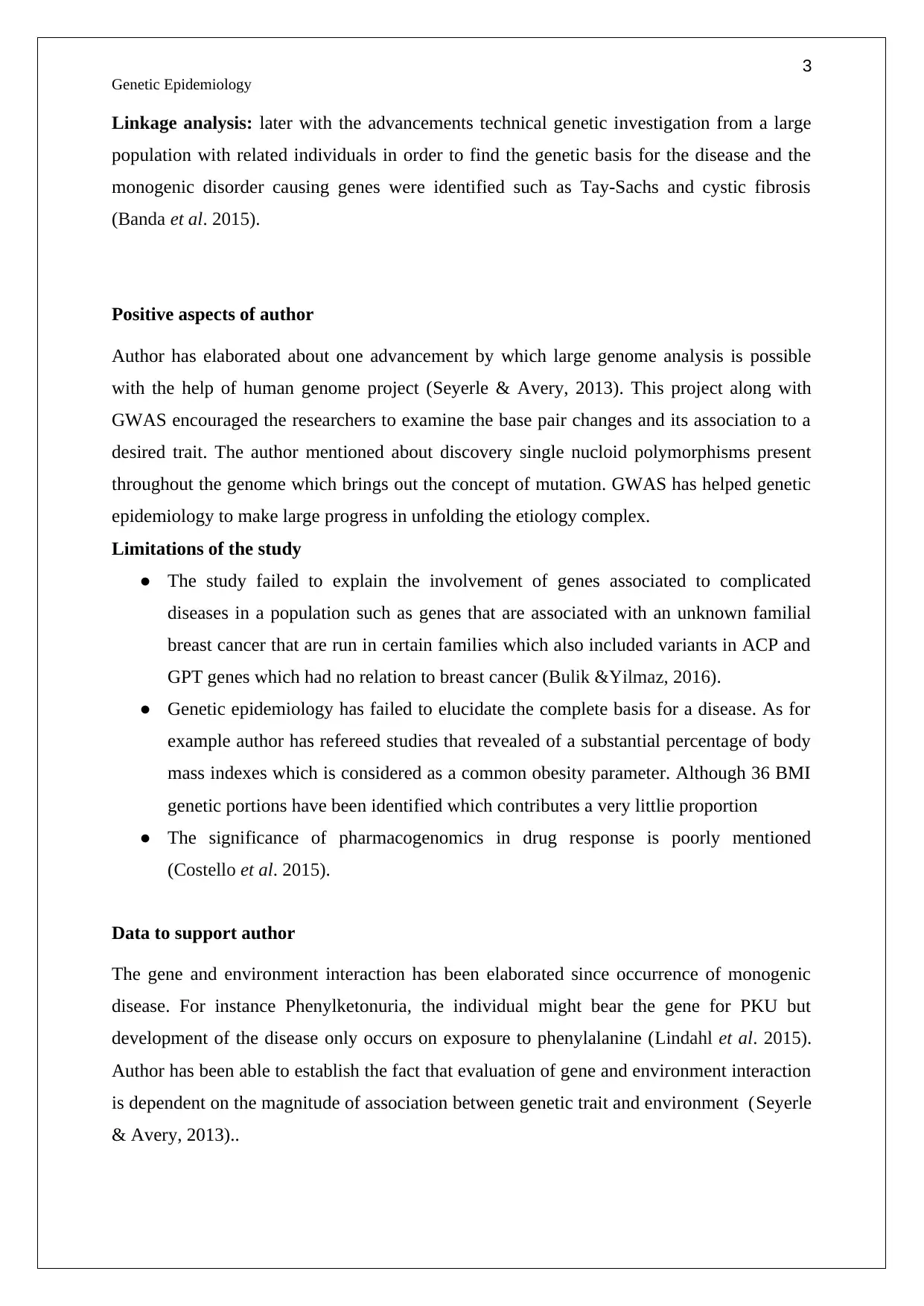
3
Genetic Epidemiology
Linkage analysis: later with the advancements technical genetic investigation from a large
population with related individuals in order to find the genetic basis for the disease and the
monogenic disorder causing genes were identified such as Tay-Sachs and cystic fibrosis
(Banda et al. 2015).
Positive aspects of author
Author has elaborated about one advancement by which large genome analysis is possible
with the help of human genome project (Seyerle & Avery, 2013). This project along with
GWAS encouraged the researchers to examine the base pair changes and its association to a
desired trait. The author mentioned about discovery single nucloid polymorphisms present
throughout the genome which brings out the concept of mutation. GWAS has helped genetic
epidemiology to make large progress in unfolding the etiology complex.
Limitations of the study
● The study failed to explain the involvement of genes associated to complicated
diseases in a population such as genes that are associated with an unknown familial
breast cancer that are run in certain families which also included variants in ACP and
GPT genes which had no relation to breast cancer (Bulik &Yilmaz, 2016).
● Genetic epidemiology has failed to elucidate the complete basis for a disease. As for
example author has refereed studies that revealed of a substantial percentage of body
mass indexes which is considered as a common obesity parameter. Although 36 BMI
genetic portions have been identified which contributes a very littlie proportion
● The significance of pharmacogenomics in drug response is poorly mentioned
(Costello et al. 2015).
Data to support author
The gene and environment interaction has been elaborated since occurrence of monogenic
disease. For instance Phenylketonuria, the individual might bear the gene for PKU but
development of the disease only occurs on exposure to phenylalanine (Lindahl et al. 2015).
Author has been able to establish the fact that evaluation of gene and environment interaction
is dependent on the magnitude of association between genetic trait and environment (Seyerle
& Avery, 2013)..
Genetic Epidemiology
Linkage analysis: later with the advancements technical genetic investigation from a large
population with related individuals in order to find the genetic basis for the disease and the
monogenic disorder causing genes were identified such as Tay-Sachs and cystic fibrosis
(Banda et al. 2015).
Positive aspects of author
Author has elaborated about one advancement by which large genome analysis is possible
with the help of human genome project (Seyerle & Avery, 2013). This project along with
GWAS encouraged the researchers to examine the base pair changes and its association to a
desired trait. The author mentioned about discovery single nucloid polymorphisms present
throughout the genome which brings out the concept of mutation. GWAS has helped genetic
epidemiology to make large progress in unfolding the etiology complex.
Limitations of the study
● The study failed to explain the involvement of genes associated to complicated
diseases in a population such as genes that are associated with an unknown familial
breast cancer that are run in certain families which also included variants in ACP and
GPT genes which had no relation to breast cancer (Bulik &Yilmaz, 2016).
● Genetic epidemiology has failed to elucidate the complete basis for a disease. As for
example author has refereed studies that revealed of a substantial percentage of body
mass indexes which is considered as a common obesity parameter. Although 36 BMI
genetic portions have been identified which contributes a very littlie proportion
● The significance of pharmacogenomics in drug response is poorly mentioned
(Costello et al. 2015).
Data to support author
The gene and environment interaction has been elaborated since occurrence of monogenic
disease. For instance Phenylketonuria, the individual might bear the gene for PKU but
development of the disease only occurs on exposure to phenylalanine (Lindahl et al. 2015).
Author has been able to establish the fact that evaluation of gene and environment interaction
is dependent on the magnitude of association between genetic trait and environment (Seyerle
& Avery, 2013)..
Paraphrase This Document
Need a fresh take? Get an instant paraphrase of this document with our AI Paraphraser
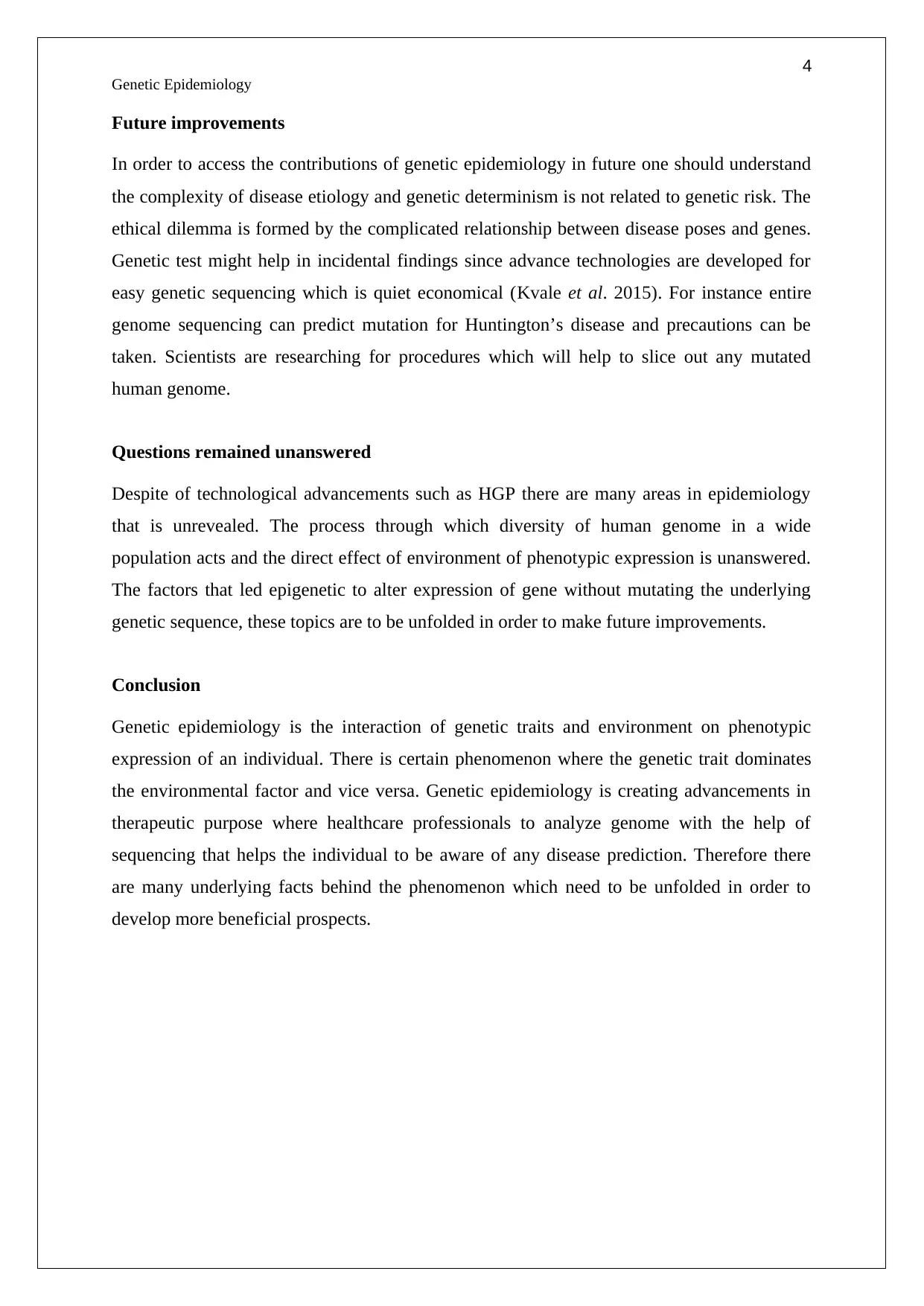
4
Genetic Epidemiology
Future improvements
In order to access the contributions of genetic epidemiology in future one should understand
the complexity of disease etiology and genetic determinism is not related to genetic risk. The
ethical dilemma is formed by the complicated relationship between disease poses and genes.
Genetic test might help in incidental findings since advance technologies are developed for
easy genetic sequencing which is quiet economical (Kvale et al. 2015). For instance entire
genome sequencing can predict mutation for Huntington’s disease and precautions can be
taken. Scientists are researching for procedures which will help to slice out any mutated
human genome.
Questions remained unanswered
Despite of technological advancements such as HGP there are many areas in epidemiology
that is unrevealed. The process through which diversity of human genome in a wide
population acts and the direct effect of environment of phenotypic expression is unanswered.
The factors that led epigenetic to alter expression of gene without mutating the underlying
genetic sequence, these topics are to be unfolded in order to make future improvements.
Conclusion
Genetic epidemiology is the interaction of genetic traits and environment on phenotypic
expression of an individual. There is certain phenomenon where the genetic trait dominates
the environmental factor and vice versa. Genetic epidemiology is creating advancements in
therapeutic purpose where healthcare professionals to analyze genome with the help of
sequencing that helps the individual to be aware of any disease prediction. Therefore there
are many underlying facts behind the phenomenon which need to be unfolded in order to
develop more beneficial prospects.
Genetic Epidemiology
Future improvements
In order to access the contributions of genetic epidemiology in future one should understand
the complexity of disease etiology and genetic determinism is not related to genetic risk. The
ethical dilemma is formed by the complicated relationship between disease poses and genes.
Genetic test might help in incidental findings since advance technologies are developed for
easy genetic sequencing which is quiet economical (Kvale et al. 2015). For instance entire
genome sequencing can predict mutation for Huntington’s disease and precautions can be
taken. Scientists are researching for procedures which will help to slice out any mutated
human genome.
Questions remained unanswered
Despite of technological advancements such as HGP there are many areas in epidemiology
that is unrevealed. The process through which diversity of human genome in a wide
population acts and the direct effect of environment of phenotypic expression is unanswered.
The factors that led epigenetic to alter expression of gene without mutating the underlying
genetic sequence, these topics are to be unfolded in order to make future improvements.
Conclusion
Genetic epidemiology is the interaction of genetic traits and environment on phenotypic
expression of an individual. There is certain phenomenon where the genetic trait dominates
the environmental factor and vice versa. Genetic epidemiology is creating advancements in
therapeutic purpose where healthcare professionals to analyze genome with the help of
sequencing that helps the individual to be aware of any disease prediction. Therefore there
are many underlying facts behind the phenomenon which need to be unfolded in order to
develop more beneficial prospects.
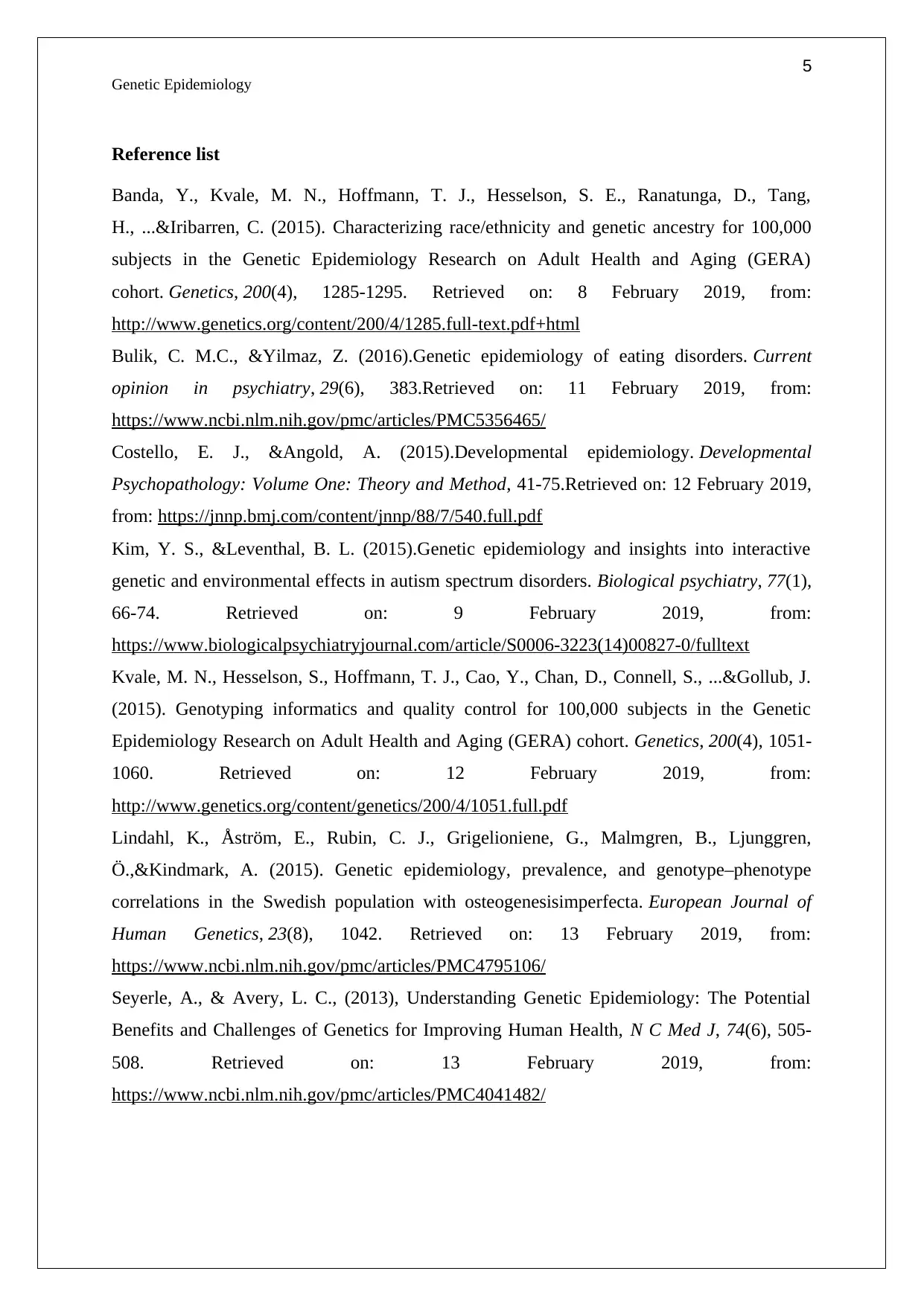
5
Genetic Epidemiology
Reference list
Banda, Y., Kvale, M. N., Hoffmann, T. J., Hesselson, S. E., Ranatunga, D., Tang,
H., ...&Iribarren, C. (2015). Characterizing race/ethnicity and genetic ancestry for 100,000
subjects in the Genetic Epidemiology Research on Adult Health and Aging (GERA)
cohort. Genetics, 200(4), 1285-1295. Retrieved on: 8 February 2019, from:
http://www.genetics.org/content/200/4/1285.full-text.pdf+html
Bulik, C. M.C., &Yilmaz, Z. (2016).Genetic epidemiology of eating disorders. Current
opinion in psychiatry, 29(6), 383.Retrieved on: 11 February 2019, from:
https://www.ncbi.nlm.nih.gov/pmc/articles/PMC5356465/
Costello, E. J., &Angold, A. (2015).Developmental epidemiology. Developmental
Psychopathology: Volume One: Theory and Method, 41-75.Retrieved on: 12 February 2019,
from: https://jnnp.bmj.com/content/jnnp/88/7/540.full.pdf
Kim, Y. S., &Leventhal, B. L. (2015).Genetic epidemiology and insights into interactive
genetic and environmental effects in autism spectrum disorders. Biological psychiatry, 77(1),
66-74. Retrieved on: 9 February 2019, from:
https://www.biologicalpsychiatryjournal.com/article/S0006-3223(14)00827-0/fulltext
Kvale, M. N., Hesselson, S., Hoffmann, T. J., Cao, Y., Chan, D., Connell, S., ...&Gollub, J.
(2015). Genotyping informatics and quality control for 100,000 subjects in the Genetic
Epidemiology Research on Adult Health and Aging (GERA) cohort. Genetics, 200(4), 1051-
1060. Retrieved on: 12 February 2019, from:
http://www.genetics.org/content/genetics/200/4/1051.full.pdf
Lindahl, K., Åström, E., Rubin, C. J., Grigelioniene, G., Malmgren, B., Ljunggren,
Ö.,&Kindmark, A. (2015). Genetic epidemiology, prevalence, and genotype–phenotype
correlations in the Swedish population with osteogenesisimperfecta. European Journal of
Human Genetics, 23(8), 1042. Retrieved on: 13 February 2019, from:
https://www.ncbi.nlm.nih.gov/pmc/articles/PMC4795106/
Seyerle, A., & Avery, L. C., (2013), Understanding Genetic Epidemiology: The Potential
Benefits and Challenges of Genetics for Improving Human Health, N C Med J, 74(6), 505-
508. Retrieved on: 13 February 2019, from:
https://www.ncbi.nlm.nih.gov/pmc/articles/PMC4041482/
Genetic Epidemiology
Reference list
Banda, Y., Kvale, M. N., Hoffmann, T. J., Hesselson, S. E., Ranatunga, D., Tang,
H., ...&Iribarren, C. (2015). Characterizing race/ethnicity and genetic ancestry for 100,000
subjects in the Genetic Epidemiology Research on Adult Health and Aging (GERA)
cohort. Genetics, 200(4), 1285-1295. Retrieved on: 8 February 2019, from:
http://www.genetics.org/content/200/4/1285.full-text.pdf+html
Bulik, C. M.C., &Yilmaz, Z. (2016).Genetic epidemiology of eating disorders. Current
opinion in psychiatry, 29(6), 383.Retrieved on: 11 February 2019, from:
https://www.ncbi.nlm.nih.gov/pmc/articles/PMC5356465/
Costello, E. J., &Angold, A. (2015).Developmental epidemiology. Developmental
Psychopathology: Volume One: Theory and Method, 41-75.Retrieved on: 12 February 2019,
from: https://jnnp.bmj.com/content/jnnp/88/7/540.full.pdf
Kim, Y. S., &Leventhal, B. L. (2015).Genetic epidemiology and insights into interactive
genetic and environmental effects in autism spectrum disorders. Biological psychiatry, 77(1),
66-74. Retrieved on: 9 February 2019, from:
https://www.biologicalpsychiatryjournal.com/article/S0006-3223(14)00827-0/fulltext
Kvale, M. N., Hesselson, S., Hoffmann, T. J., Cao, Y., Chan, D., Connell, S., ...&Gollub, J.
(2015). Genotyping informatics and quality control for 100,000 subjects in the Genetic
Epidemiology Research on Adult Health and Aging (GERA) cohort. Genetics, 200(4), 1051-
1060. Retrieved on: 12 February 2019, from:
http://www.genetics.org/content/genetics/200/4/1051.full.pdf
Lindahl, K., Åström, E., Rubin, C. J., Grigelioniene, G., Malmgren, B., Ljunggren,
Ö.,&Kindmark, A. (2015). Genetic epidemiology, prevalence, and genotype–phenotype
correlations in the Swedish population with osteogenesisimperfecta. European Journal of
Human Genetics, 23(8), 1042. Retrieved on: 13 February 2019, from:
https://www.ncbi.nlm.nih.gov/pmc/articles/PMC4795106/
Seyerle, A., & Avery, L. C., (2013), Understanding Genetic Epidemiology: The Potential
Benefits and Challenges of Genetics for Improving Human Health, N C Med J, 74(6), 505-
508. Retrieved on: 13 February 2019, from:
https://www.ncbi.nlm.nih.gov/pmc/articles/PMC4041482/
⊘ This is a preview!⊘
Do you want full access?
Subscribe today to unlock all pages.

Trusted by 1+ million students worldwide
1 out of 6
Related Documents
Your All-in-One AI-Powered Toolkit for Academic Success.
+13062052269
info@desklib.com
Available 24*7 on WhatsApp / Email
![[object Object]](/_next/static/media/star-bottom.7253800d.svg)
Unlock your academic potential
Copyright © 2020–2025 A2Z Services. All Rights Reserved. Developed and managed by ZUCOL.





